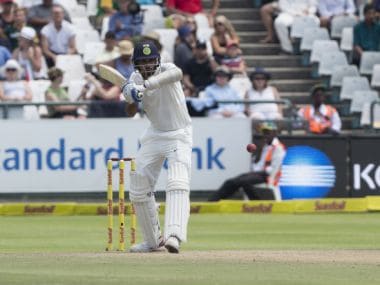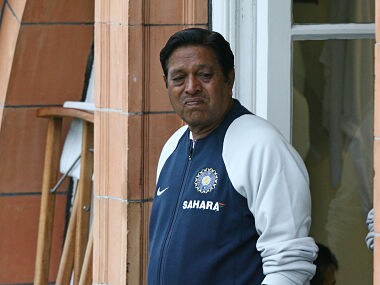India vs South Africa: Bhuvneshwar Kumar's understated utility with bat could be the lower-order push visitors need
With the South African tour already making headlines for India's batting fallacies, Bhuvneshwar's seemingly minor, yet important role, in the lower order could help add vital runs at the end. In a contest between world’s top two Test teams, those extra runs might just be the difference.
Rohit Sankar, Jan,12 2018
- Pakistan in New Zealand, 5 ODI Series, 2018 NZ Vs PAK New Zealand beat Pakistan by 61 runs (D/L method)
- India in South Africa, 3 Test Series, 2018 SA Vs IND South Africa beat India by 72 runs
- The Ashes, 2017/18 AUS Vs ENG Australia beat England by an innings and 123 runs
- West Indies in New Zealand, 3 T20I Series, 2017/18 NZ Vs WI New Zealand beat West Indies by 119 runs
| Rank | Team | Points | Rating |
|---|---|---|---|
| 1 | India | 4969 | 124 |
| 2 | South Africa | 3888 | 111 |
| 3 | Australia | 4174 | 104 |
| 4 | New Zealand | 3489 | 100 |
| 5 | England | 4829 | 99 |
| 6 | Sri Lanka | 4058 | 94 |
| Rank | Team | Points | Rating |
|---|---|---|---|
| 1 | South Africa | 6386 | 120 |
| 2 | India | 6680 | 119 |
| 3 | Australia | 5948 | 114 |
| 4 | England | 6156 | 114 |
| 5 | New Zealand | 6109 | 113 |
| 6 | Pakistan | 4684 | 98 |
| Rank | Team | Points | Rating |
|---|---|---|---|
| 1 | New Zealand | 2262 | 126 |
| 2 | Pakistan | 2843 | 124 |
| 3 | India | 3385 | 121 |
| 4 | England | 2029 | 119 |
| 5 | West Indies | 2538 | 115 |
| 6 | South Africa | 2238 | 112 |





Vernon Philander had gone wicketless for three overs and the South African dressing room was starting to panic with the India lower-order beginning to fight their way to the target of 208 in the final innings of the first Test. But Newlands was his backyard and all Philander needed was a moment of magic, which skipper Faf du Plessis provided when he moved Quinton de Kock upto the stumps to prevent Ravichandran Ashwin from batting outside the crease. The edge was found on the first ball and four balls later, the Indian innings and the Test was wrapped up by the Big Vern.
Bhuvneshwar Kumar bats on the second day of the first Test in Cape Town. AP
du Plessis’ outstanding captaincy, de Kock's brilliant catch, Philander's unerring accuracy and even Ashwin's brave innings were talked about in depth after the match. Few noticed the forlorn, desolate, despondent soul at the other end holding a bat and helplessly watching three batsmen being dismissed in the space of four balls — Bhuvneshwar Kumar.
The Cape Town Test’s report will always have his name in bold for his remarkable spell on Day 1 that had South Africa staring down the abyss. But little would be there on Bhuvneshwar, the batsman, who was involved in the highest partnership in both of India's innings — 99 with Hardik Pandya in the first and 49 with Ashwin in the second.
The swing bowler from Meerut, who had South African batsmen dancing to his tunes with the ball, put up a more than gritty show with the bat, virtually bringing India’s slide to a temporary halt in both innings.
He walked out to bat in the first innings with the tourists down and out at 92/7. A recovery from there seemed nearly impossible, but for Pandya's flamboyant, counter-attacking 93. However, Pandya could well have remained stranded at one end if Bhuvneshwar hadn't put his hand up and blunted the South African attack.
While the attention-grabbing innings from Pandya was worth every penny, Bhuvneshwar's 86-ball 25, coming at a strike rate of 29.07 was as good a supporting act as any. He played six balls less than Pujara, made one run less, and importantly gave Hardik Pandya the assurance that his end was impregnable.
Make no mistake, Bhuvneshwar is not the most sublime or elegant of batsmen. But he knows where his off-stump is, leaves pretty well and crucially, does not gift his wicket away.
He showed evidence of his impeccable temperament in the second innings too, when India were blown away in a chase of 208. He assumed the wingman role once again, this time to Ravichandran Ashwin, and the duo put on a 49-run partnership to resuscitate the innings from 82/7. He played out 41 balls this time — the second most number of balls faced by an Indian batsman in the innings — and watched from the other end as Philander scythed through the lower order.
The role isn't completely unfamiliar to Bhuvneshwar. At Lord's in 2014, on a seaming surface, he acted as the perfect foil to Ajinkya Rahane in the first innings, making 36 from 84 balls while the middle-order batsman completed a ton. He then played counter-attacking role in the second innings with Ravindra Jadeja in an enterprising 99-run stand that helped India set a target that would eventually be too good for England.
In fact, he made three half-centuries in the series, all on surfaces where India’s batsmen struggled to make an impact. He was India’s fourth-highest run-scorer in the series with 247 runs and an average better than that of Cheteshwar Pujara, Virat Kohli, Rohit Sharma and Shikhar Dhawan.
A year before that, in Chennai, he played the perfect second-fiddle to Mahendra Singh Dhoni as the then India captain blasted his way to a double-hundred. The duo had raised 140 runs then.
A few months back in Pallekele, in a One-Day Intentional (ODI), Akila Dananjaya, Sri Lanka's mystery spinner ran through India’s middle-order. Dhoni needed an able ally, and Bhuvneshwar stepped up once again. A 100-run partnership followed that eventually led India to victory.
"I had a plan against him (Dananjaya). He is an off-spinner but he was also bowling leg-spinners and googlies so it was a surprise for us. I just wanted to play him for the wrong-one or the googlies, which he was bringing in to me. And whatever was going away from me I wasn't really worried about that. Whatever wickets he took that was on the googly, the incoming delivery, so my plan was to counter his incoming deliveries. Initially it was a bit difficult to read him from the hand but later on when I played him for 10-15 balls I could read his variations," Bhuvneshwar had explained after his maiden ODI half-century.
The comment shows that he is a thinking batsman. It is pretty clear that Bhuvneshwar isn't somebody who can single-handedly destroy opponents with a counter-attacking blitzkrieg, but India do not want him to do that either.
His ability to rotate the strike, frustrate bowlers with dead bat defensive shots and instill further confidence in the more established batting partner makes him an invaluable asset down the order. In conditions where the top-order hasn't enjoyed fruitful returns, the visitors need every ounce of fight they can extract from their lower-order and the opening bowler has proved that he is more than a reliable player with the willow in hand.
With the South African tour already making headlines for India's batting fallacies, Bhuvneshwar's seemingly minor, yet important role, in the lower order could help add vital runs at the end. In a contest between world’s top two Test teams, those extra runs might just be the difference.
Published Date:Jan 12, 2018
| Updated Date: Jan 12, 2018
Also See
India vs South Africa: Vernon Philander's unerring accuracy re-opens visitors' wounds at Newlands
India v South Africa, 1st Test, stats review: From Vernon Philander's record at Newlands to Wriddhiman Saha's multiple feats with gloves
India vs South Africa: Bhuvneshwar Kumar produces hair-raising opening spell at Newlands to stamp tourists’ intent in crucial tour